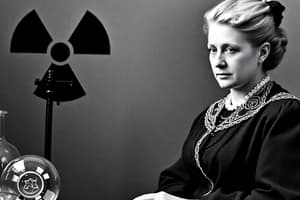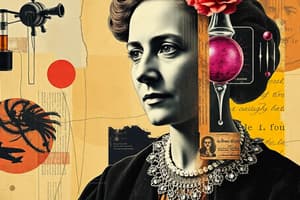Podcast
Questions and Answers
What did Marie Curie do with her Nobel Prize winnings during World War I?
What did Marie Curie do with her Nobel Prize winnings during World War I?
- Conducted personal research on radiation.
- Invested in cancer research.
- Funded a military hospital.
- Established mobile X-ray units. (correct)
What organization did Marie Curie help establish after World War I?
What organization did Marie Curie help establish after World War I?
- The World Health Organization.
- The Radiation Safety Institute.
- The Curie Foundation. (correct)
- The International Atomic Energy Agency.
What tragic consequence resulted from Marie Curie's prolonged exposure to radiation?
What tragic consequence resulted from Marie Curie's prolonged exposure to radiation?
- She suffered from chronic fatigue syndrome.
- She developed a resistance to radiation.
- She lost her ability to focus.
- She died from aplastic anemia. (correct)
How did Marie Curie contribute to the field of cancer research?
How did Marie Curie contribute to the field of cancer research?
What significant milestone did Marie and Pierre Curie achieve in 1903?
What significant milestone did Marie and Pierre Curie achieve in 1903?
What year did Rosalind Franklin produce the first sharp image of crystalline DNA?
What year did Rosalind Franklin produce the first sharp image of crystalline DNA?
Which institution did Rosalind Franklin move to in 1953?
Which institution did Rosalind Franklin move to in 1953?
What was the main focus of Franklin's work between 1947 and 1951?
What was the main focus of Franklin's work between 1947 and 1951?
Which quote is attributed to Rosalind Franklin?
Which quote is attributed to Rosalind Franklin?
What notable position did Rosalind Franklin hold at King's College, London in 1951?
What notable position did Rosalind Franklin hold at King's College, London in 1951?
What does Planck's radiation law indicate about energy emission?
What does Planck's radiation law indicate about energy emission?
Which mathematical expression represents the relationship between energy and frequency according to Planck's theory?
Which mathematical expression represents the relationship between energy and frequency according to Planck's theory?
What is the significance of Planck's constant in modern physics?
What is the significance of Planck's constant in modern physics?
How did Einstein contribute to Planck's quantum theory?
How did Einstein contribute to Planck's quantum theory?
What aspect of Planck's quantum theory has influenced modern technology?
What aspect of Planck's quantum theory has influenced modern technology?
Flashcards
What is DNA?
What is DNA?
A molecule found in all living things that carries genetic information.
What is X-ray crystallography?
What is X-ray crystallography?
A technique used to study the arrangement of atoms in a molecule using X-rays.
Who is Rosalind Franklin?
Who is Rosalind Franklin?
A British chemist who made groundbreaking discoveries about the structure of DNA using X-ray crystallography.
What is the double helix structure?
What is the double helix structure?
Signup and view all the flashcards
What was the 'DNA Race'?
What was the 'DNA Race'?
Signup and view all the flashcards
What were 'Petites Curies' ?
What were 'Petites Curies' ?
Signup and view all the flashcards
What did Marie and Pierre Curie win a Nobel Prize for?
What did Marie and Pierre Curie win a Nobel Prize for?
Signup and view all the flashcards
What did Marie Curie establish to fight cancer?
What did Marie Curie establish to fight cancer?
Signup and view all the flashcards
What caused Marie Curie's death?
What caused Marie Curie's death?
Signup and view all the flashcards
What did Marie Curie donate during World War I?
What did Marie Curie donate during World War I?
Signup and view all the flashcards
Quantum
Quantum
Signup and view all the flashcards
Planck Length
Planck Length
Signup and view all the flashcards
Planck's Quantum Theory (1900)
Planck's Quantum Theory (1900)
Signup and view all the flashcards
Planck Time
Planck Time
Signup and view all the flashcards
Planck's Constant (h)
Planck's Constant (h)
Signup and view all the flashcards
Study Notes
Rosalind Franklin
- Born in London in 1920
- Graduated from the University of Cambridge in 1941
- Became a researcher for the British Coal Utilization Research Association in 1942
- Took a role studying the structures of coal and graphite before gaining her doctorate from Cambridge in 1945
- Moved to Paris in 1947 and began studying X-ray crystallography
- Used X-rays to examine the structure of DNA and helped determine its molecular structure
- Made a crucial contribution in the 20th century.
The DNA Race
- During the 1950s, many scientists across the globe were engaged in a race to discover the molecular structure of DNA, the chemical found inside all living things.
- In 1951, Rosalind Franklin began photographing strands of DNA at King's College in London where a group of physicists and biochemists were trying to use physics to study biological molecules.
- In 1952, she produced the first sharp image of crystallised DNA. This revealed the double helix shape of DNA.
Milestones
- Became a researcher for BCURA, the British Coal Utilization Research Association in 1942
- Took a role as head of X-ray research at King's College in London in 1951
- Moved to Birkbeck College in London in 1953, and continued work on major crop viruses.
Studying That Suits You
Use AI to generate personalized quizzes and flashcards to suit your learning preferences.





